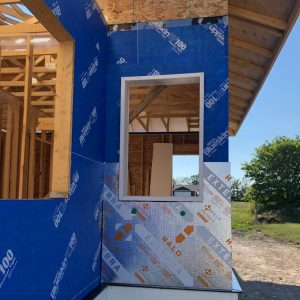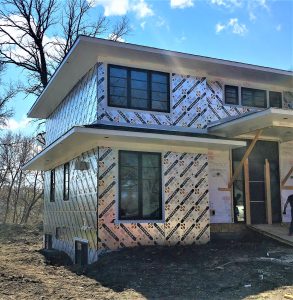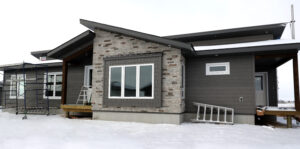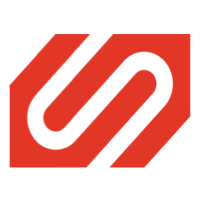Fresh out of university I landed a challenging and exciting role with a leading global insulation manufacturer.
Through almost a decade with the company I learned a tremendous amount that help shaped my career in terms of my values and the voice for change that I wanted to have in the construction industry. A few years into the role my wife and I had the opportunity to build a new home with a medium sized production builder in Ontario, Canada. (cold climate zone 5, heating degree days of 3460).
I thought this was an amazing opportunity to implement my building science and enclosure knowledge and leverage the skills I had recently learned while participating on the ecoEII Net Zero Energy Housing Demonstration Project with the National Research Council of Canada (NRCan). The ecoEII Net Zero Energy Housing Demonstration Project gathered five production home builders from across Canada to built net-zero energy market-ready homes with off the shelf technology.
At the conclusion of the project the builders constructed 11 Net Zero Energy (NZE) single-family dwellings, one four-unit NZE row house, one NZE Multi-Unit Residential Building (MURB) comprised of 6 units, and five Net Zero Energy Ready (NZER) houses.
The houses constructed represented an important step towards the broader adoption of low operational carbon houses and provided critical insight into how these homes could be constructed cost-effectivity. The complete findings of the demonstration project can be found here: Net Zero Energy and Net Zero Energy Ready Housing – Lessons learned and key findings (nrcan.gc.ca).
The recipe for a NZER or NZE house includes a building enclosure that incorporates optimized levels of insulation that limit thermal bridging, achieves exceptional levels of airtightness, engages fenestrations that have a low U-value, and implements high-efficiency mechanical equipment. With this recipe in mind and the support of the builder my NZER house that was constructed in 2014 featured the following attributes as noted in Table 1.s
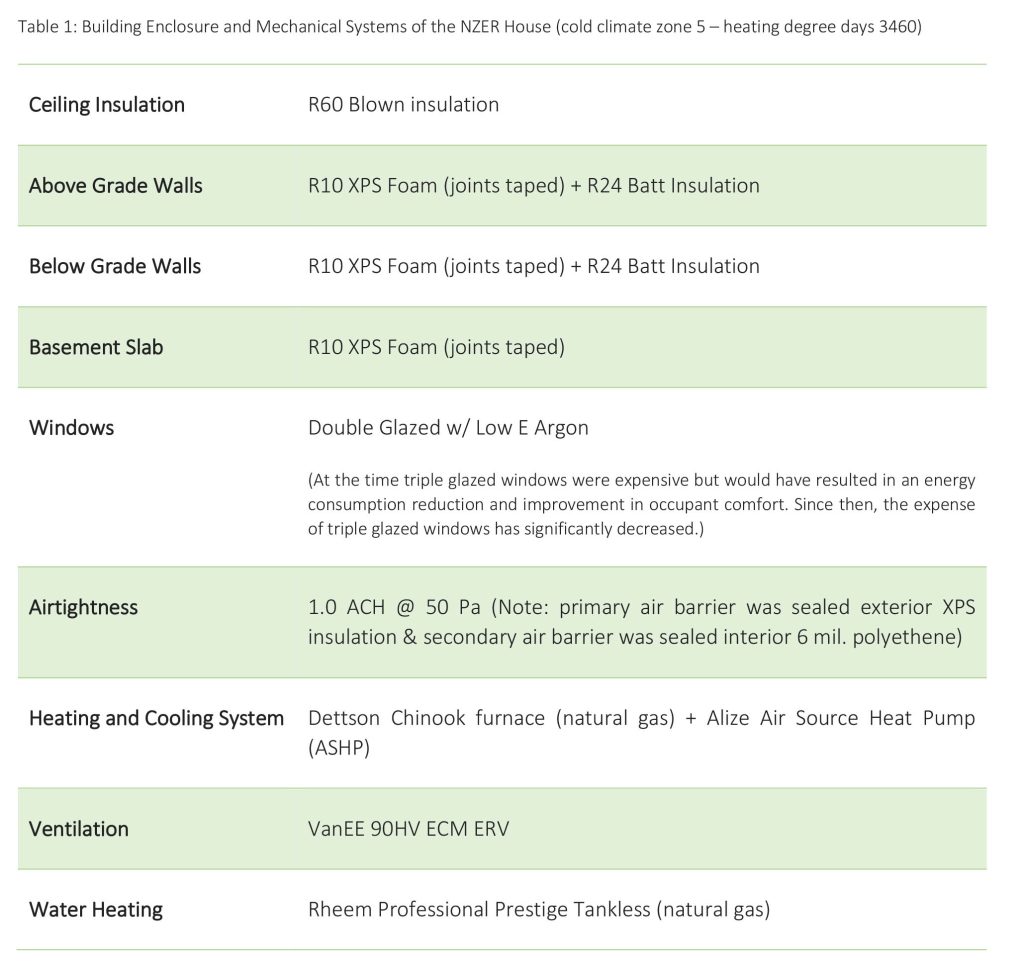
With the parameters noted in Table 1 an energy model was developed in HOT2000 to approximate the houses annual energy consumption, which revealed a utilization of 61 GJ (Figure 1).
If this house was built to the minimum requirements of the 2017 SB-12 Supplementary Standards from the Ontario Building Code (OBC) it would consume an additional 36 GJ of energy per year.
Further modelling in HOT2000 revealed additional measures that could have been taken to further reduce the NZER houses 61 GJ of energy consumption that include the inclusion of triple glazed windows and an air source heat pump hot water tank.
These two measures would have reduced the annual energy consumption by another 10 – 15 GJ a year. At the time both were expensive technologies to implement, thankfully those costs now have come down and these measures can be implemented on projects to further reduce energy consumption.
Based on the information so far, you may be thinking, “How or where does this house fail from a sustainability perspective?”.
Before getting into that, how is sustainability defined? In my opinion, sustainability consists of fulfilling the needs of the current generations without compromising the needs of future generations.
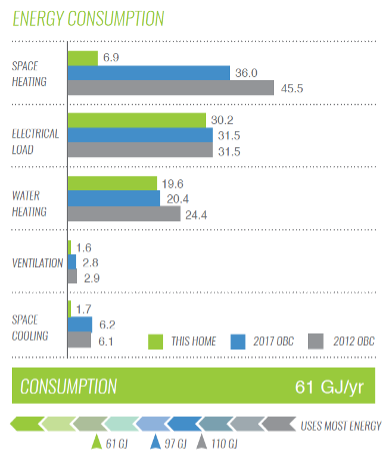
The NZER house that I constructed has low operation carbon, however, at the time an analysis of the embodied carbon was not completed. For a building to be truly sustainable both the operational and embodied carbon must be low to ensure a limited negative impact on the environment.
The three materials driving a higher embodied carbon value for my NZER house include regular concrete, the brick cladding, and XPS insulation (Figure 2).
Today, the embodied carbon of concrete can be significantly reduced. First, you can switch from regular Portland cement to Portland limestone cement (PLC) for a 10% GWP reduction.
Secondly, there are alternative mixes available such as supplementary cementing materials (SCMs). The SCMs replace a portion of the Portland cement, which improves the environmental footprint of concrete by a reduction in the green house gas emissions (GHG) and air pollutants. Often SCMs are by-products from other industrial processes, so by utilizing these materials in concrete mixes, materials are diverted from landfills. To illustrate, here is an EPD from Concrete Ontario which outlines GWP reductions in the order of about 33% that can result from the use of SCMs.
And thirdly, there are a number of emerging concrete carbon capture technologies in the market place – check out this article for a quick summary.
Bricks are also improving their environmental footprint with the introduction of manufactured bricks that do not require high temperature firing and limit the use of materials such as Portland cement in the manufacturing process. If low carbon bricks aren’t available in your market alternative cladding options include fiber cement panels or carbon capturing products such as wood or wood composite claddings (Figure 3).
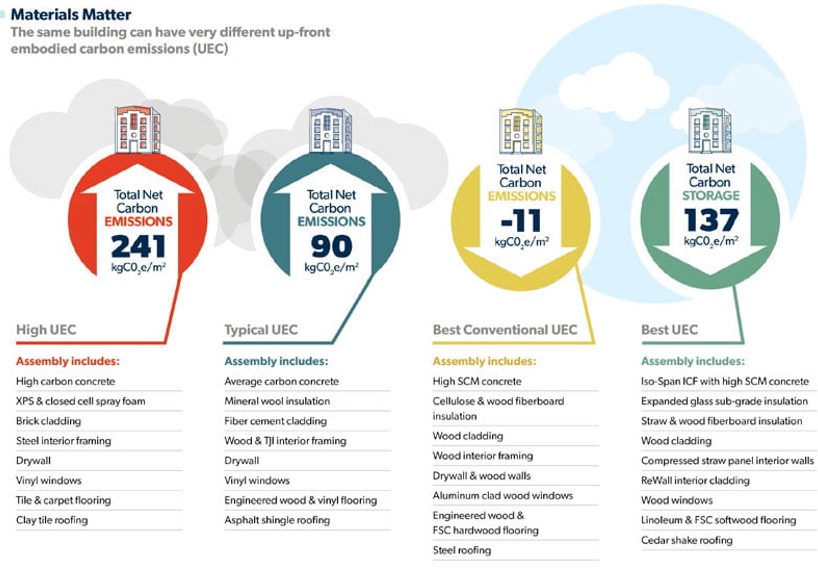
As for XPS, the graphic in Figure 2 could be referencing the old formulation of XPS foam insulation, however, is the new formulation any better and what is the difference between the two formulations?
The old formulation of XPS is manufactured with HFC-134a, whereas the new formulation is manufactured without HFC-134a or a blend that limits the amount of HFC-134a. In terms of which product you will get all depends where the project is located.
As of January 1st, 2021 the Environmental and Climate Change Canada prohibits any individual to manufacture a foam product that contains a hydrofluorocarbon (HFC) blowing agent. In the United States of America (USA) the Environmental Protection Agency (EPA) stated in 2015 the use of HFC-134a would end January 1st, 2021, however later retracted that mandate in favour of Proposed Rule 23 (Proposed Rule 23 – Protection of Stratospheric Ozone: New and Revised Listings for the Significant New Alternatives Policy Program (epa.gov)) that was implemented under a program called Significant New Alternations Policy (SNAP).
The EPA will accept the use of HFC-134a in three specific “blends”. It should be noted only one XPS manufacturer was leading the charge against the revision, while other XPS manufacturers noted they were able to comply producing a product without HFC-134a. In summary, any XPS product manufactured and sold in Canada cannot contain HFC-134a, while certain states in the USA allow XPS to use a blend of HFC-134a while other states require XPS insulation that is HFC-134a free.
Getting back to the original questions, of how much better is the new XPS formulation than the old formulation, how does a graphite expanded polystyrene rigid insulation (GPS) such as Halo® Exterra® by Logix Brands compare, and could it replace the XPS foam insulation to achieve a truly sustainable solution for NZER or NZE housing?
Often individuals looking to build sustainable houses select expanded polystyrene (EPS) because its blowing agent, pentane, has a very low global warming potential (GWP). GPS is simply EPS insulation that has been infused with graphite to enhance the products thermal resistance.
The new formulation of XPS insulation reduced its energy consumption during the manufacturing process by approximately 2.14 MJ (Table 2), a small but measurable amount.
Depending on the type of GPS insulation the product will either have a substantially lower energy consumed during the manufacturing process than XPS insulation or a slightly higher value. For some reason the fresh water used in the manufacturing process increased by 0.09m3 moving to the new formulation of XPS insulation and represents a freshwater usage roughly 45 – 58 times higher than a GPS insulation.
As advertised by the XPS manufacturer there was a significant reduction in the total GWP thanks to the removal of HFC-134a. However, the GWP of the new XPS insulation is still two to three times higher than an equivalent GPS insulation.
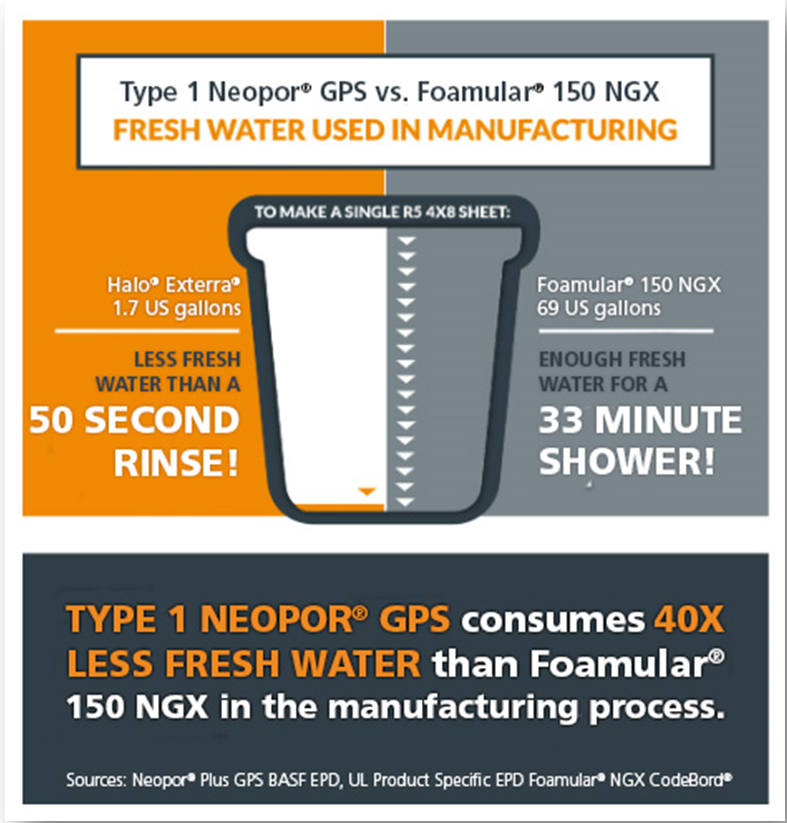
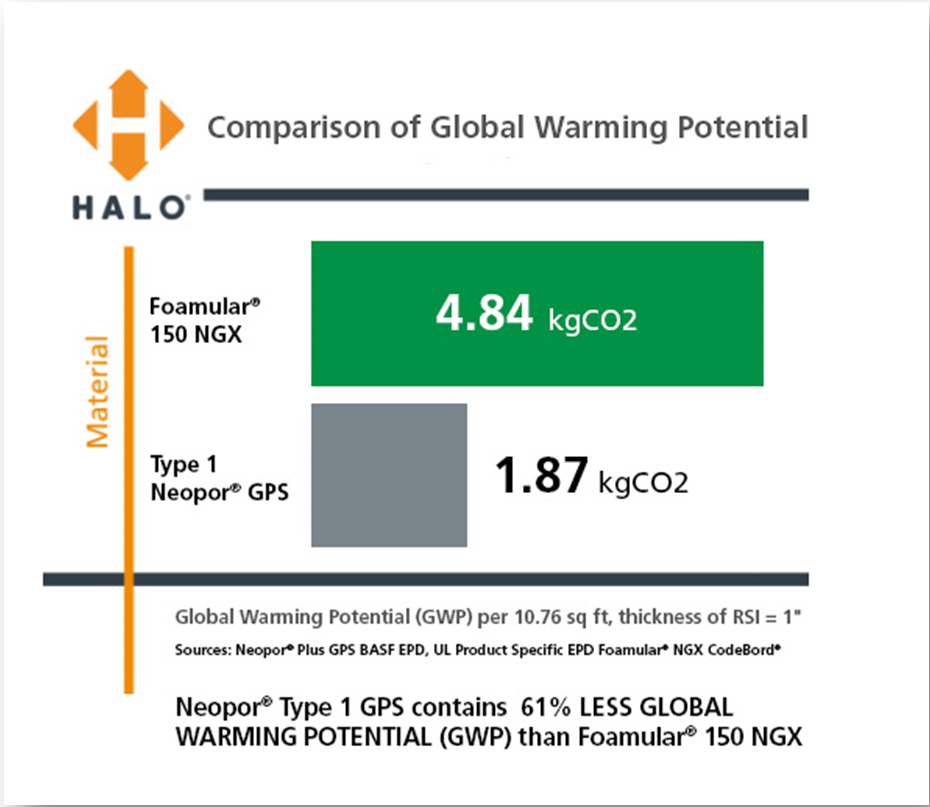
Although improvements have been made to the formulation of XPS insulations, the attributes still rank it at the top when comparing carbon emissions of various insulations (Figure 4). Material selection matters in developing sustainable houses that have low embodied in addition to operational carbon emissions.
With the low carbon emissions and preference of utilization by industry stakeholders interested in developing truly green buildings, GPS insulations are a good reference to a sustainable insulation that could be selected for a NZER or NZE house.
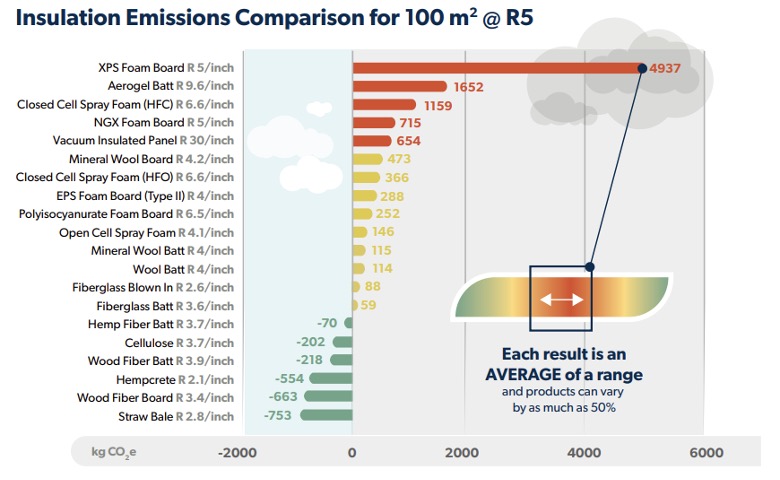
Within the last 5 to 10 years there has been an explosion in demand from industry stakeholders within the construction industry inquiring about the impacts to the environment from manufactured products. Individuals can view these impacts from an individual product or based on an industry wide average from an environmental product declaration (EPD) report.
This document is a signal from a manufacturer or association representing various manufacturers their commitment to measuring (and hopefully reducing) the environmental impacts of a product as it tells the life cycle storey from extraction of raw materials to end of life use. Unfortunately, EPD’s are single documents and there’s no combined report that allows an individual to quickly compare products.
Thankfully Builders for Climate Action have developed a tool called Building Emissions Accounting for Materials (BEAM). The tool allows an individual to calculate the approximate carbon emissions of their building based on materials they typically choose and then see how those emissions can be reduced through a selection of alternative materials.
To use the tool an individual must simply input the dimensions of their building (low-and mid-rise residential buildings only) and a comprehensive list of all available materials will populate for each building assembly (Figure 5). Each material will have a carbon emissions value, which allows an opportunity to quickly compare materials and select a material that fits the scope of the project. More information about BEAM can be found at BEAM Estimator – BUILDERS FOR CLIMATE ACTION.
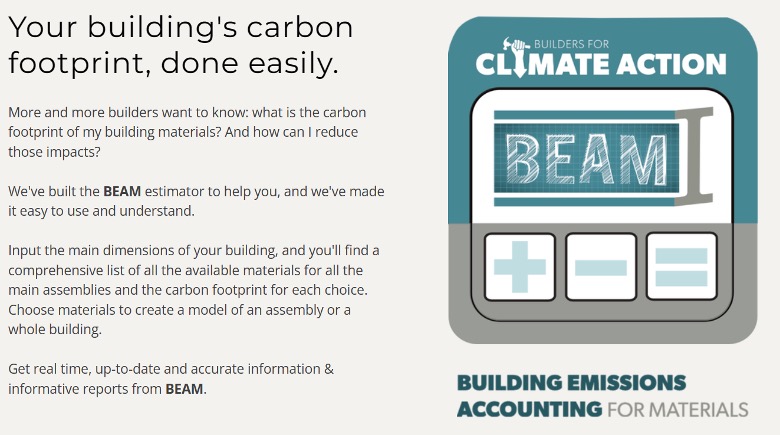

Don't miss a thing!
Subscribe for exclusive content, insider industry news and limited edition webcasts.
Hopefully this article has shed light on the importance of constructing houses that feature low operational carbon emissions (energy usage) as well as embodied carbon emissions (manufactured materials).
As Chris Magwood notes the building industry is good at reducing operational carbon emissions, however, the industry needs to stop developing (today) high embodied carbon emission buildings and move towards low (moderate to zero) or storing carbon instead over the next 5 to 10 years to limit the advancement of climate change. EPD’s and tools like BEAM help industry stakeholders evaluate and select low carbon emission materials that can be incorporated into truly sustainable buildings that meet the needs of current and future generations.
Selecting foam insulation materials like Halo® Exterra® provides a platform for the development of an energy efficient house (operational carbon) and ensures embodied carbon has been limited as well.
Written by
Tyler Simpson MB Sc., Certified Passive House Designer
LOGIX BRANDS
Manager of Technical Services & Building Science Canada
Source Links:


